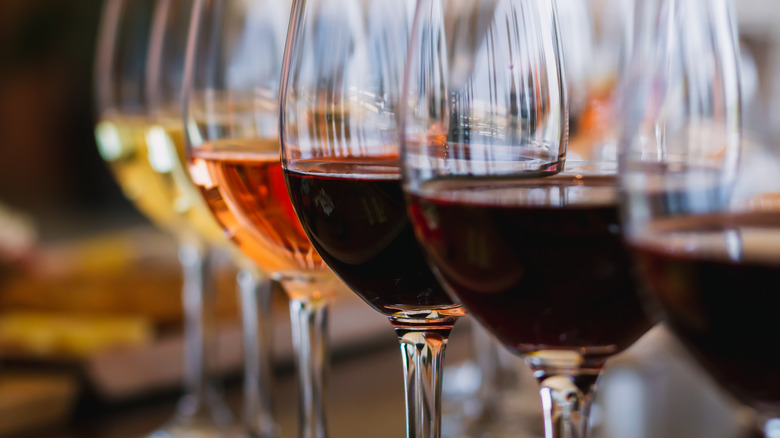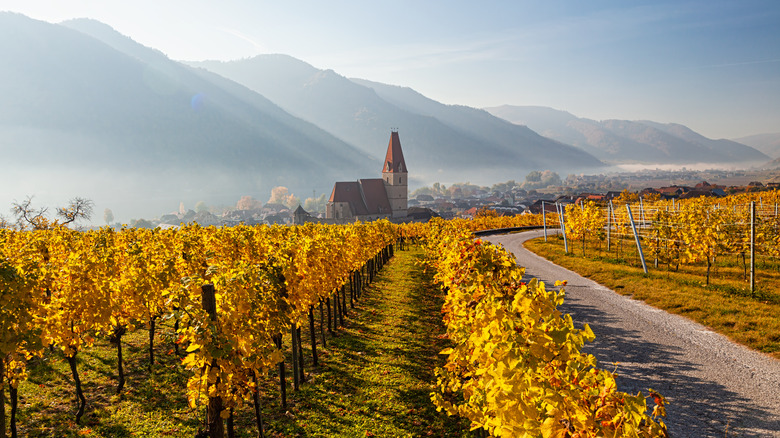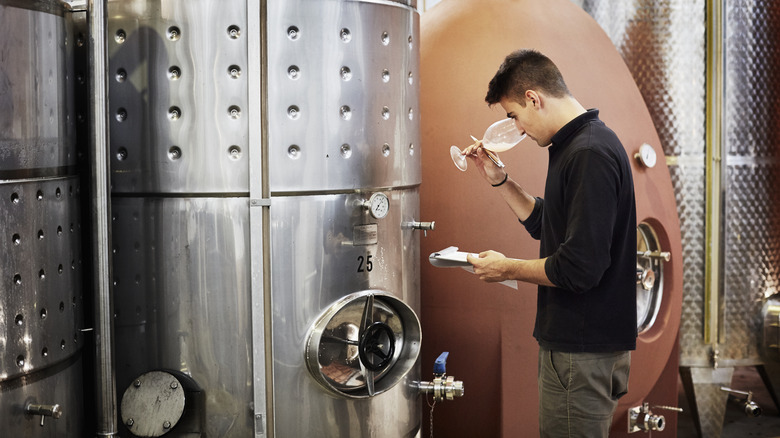The Sugar-Free Label On Wine Doesn't Mean What You Think
All wine is made with sugar — it's just usually naturally occurring sugar. Grapes develop natural sugars just like any other fruit, and then yeast eats that sugar and converts it into alcohol to make wine. Without sugar, the yeast would have no food, and all you'd have is a bottle of really — frankly — gross grape water. And no one wants that. Sometimes, sugar is added during the fermentation process to boost the alcohol content, which is called chaptalization, or in a process called backsweetening, which is not as common, and is when vintners (winemakers) add sugar after fermentation to create a sweeter final wine; sometimes this is to make a wine that's sweet on the palate, and sometimes this is done to balance an acidic product.
The "sugar-free" label on some wines doesn't mean that there is zero sugar inside, it simply means there is no additional sugar added to the bottle. There may still be up to 1 gram per liter of residual, natural sugar in the bottle. A label that reads "sugar-free" means there was no chaptalization, no backsweetening, and no grape concentrate added to boost the sweetness of the wine.
This doesn't mean that wines that don't bear that label aren't also naturally low-sugar. This label doesn't really tell the whole story, and it doesn't necessarily designate that a wine is better than one not bearing that label; it is primarily a marketing ploy. With a little wine knowledge, you can easily find a wine with low sugar without relying on that "sugar-free" label.
Find lower sugar wines based on where they were grown
Grapes develop sugars as they ripen and they develop more sugar in certain climates — namely hot, dry climates. Late-season rains can dilute the Brix, or the sugar level, of the grapes, leading to a lower-sugar yield. Grapes grown in cooler temperatures naturally have lower sugar and higher acidity.
Basically, think about places farther from the equator that are known for being damp or getting snow. For the northern hemisphere, this includes the Alsace region of France and Austria, northern Germany, the Finger Lakes and Niagra Falls regions of New York State, western Oregon, and western Washington. Even certain areas of famous wine regions, like the northern sections of the Rhône Valley, are known for their cooler temperatures. In the southern hemisphere, areas of southern Australia, like the Clare Valley, and New Zealand fit the bill. Very high-altitude vineyards tend to be a lot cooler than valley-floor vineyards, but sometimes these vineyards are terraced to receive the most sunlight (and warmth) possible, so this isn't always a dead giveaway. In that case, there are other things to check.
White grapes are generally picked at lower Brix levels than red grapes. However, allowing complete fermentation can take a bold, red, high-Brix grape and turn it into a no-sugar wine. There are a couple of things to look for, including how "dry" the label says it is, as well as its ABV, or alcohol by volume percentage.
Low sugar wines might depend on the winemaking process
Wines have an identification system for how much sugar is in the bottle. A "bone dry" still wine might not have a sugar-free label, but with less than one gram of residual sugar per liter, it still has as little (maybe less!) sugar as a wine with a sugar-free label. A "dry" wine can have anywhere from one to six grams of sugar per liter; in the E.U., a dry wine can only have up to 4 grams per liter by regulation, but the U.S. doesn't have the same regulatory system. In sparkling wine, "brut nature" and "extra brut" are the equivalent of extra dry and dry, with up to three and six grams of sugar per liter allowed, respectively.
The next thing to look at is the ABV. Generally, the higher the ABV in a cool climate wine, the lower the sugar. A German riesling with 13% ABV will have less sugar than an 11% ABV wine because the latter stopped fermentation early to produce a sweeter wine with higher residual sugar. A bold red from a warm climate described as "bone dry" will also have lower residual sugar.
Finally, though it's not a sure-fire, tell-tale sign, cheaper wine often masks under-developed or underperforming flavors with sugar. Though there's nothing inherently wrong with sweet or less expensive wine, it may contain more sugar than a higher-priced bottle. So when looking for a lower-sugar wine, opt for dry wines produced in colder climates. If all else fails, see if the winery has a technical sheet online listing the vintage's residual sugar.


